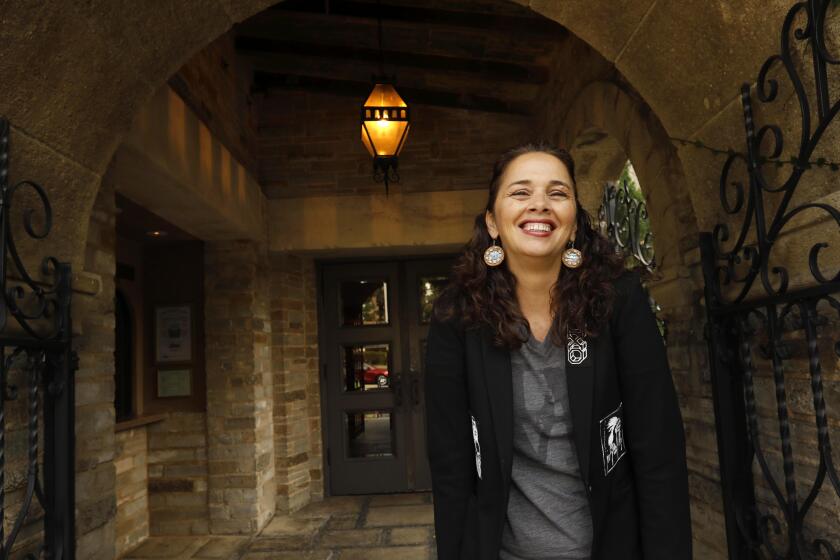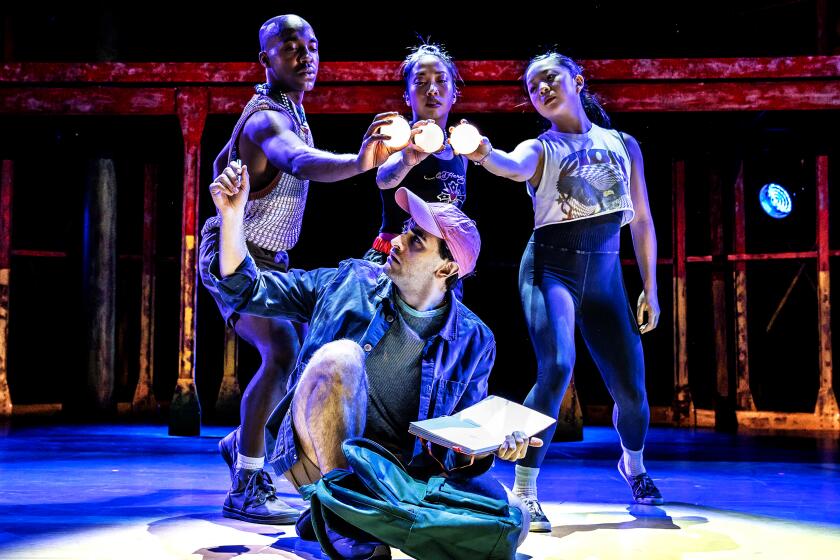Jennifer Tipton is an artist using light
Lighting designer Jennifer Tipton met Sardono W. Kusumo, an Indonesian dancer and choreographer, in 2008 at a workshop she was giving in Java. Tipton, one of this country’s preeminent designers, had participants reverse their usual roles: Lighting designers made dance pieces; choreographers lighted them.
Returning to Jakarta later that year, Tipton discovered a different kind of artistic shift. Sardono, known for his intense physical style, had begun painting. He was producing massive canvases, up to 30 feet high. “I like to throw my body around a space, so for a dancer, painting is almost antisocial,” Sardono said. “But when Jennifer saw them, she said, ‘I see so many lights in your paintings. Let’s find a way to show them.’”
Two years later, Tipton and Sardono Dance Theater are collaborating on “Rain Coloring Forest,” an evening of music, dance and visuals at REDCAT, running for three performances starting Sept. 16. Sardono’s epic canvases are the “set” for the show, which features music by David Rosenboom.
Largely unknown by the public, Tipton is revered within her profession, an interdisciplinary artist whose four decades of design have won her two Tonys, two Bessies, an Olivier, and a MacArthur “genius” grant. Her collaborators are pioneers: Robert Wilson, Peter Sellars, the Wooster Group, Mikhail Baryshnikov, Andrei Serban, Paul Taylor. Some of their best work has been marked by Tipton’s artistry. As Wilson put it, “When you see a work that she has done, you know it is Tipton lighting. That can only be said about a few people.”
Los Angeles audiences will have a chance to identify Tipton’s signature this fall: she’s lighting most of Grand Avenue. Along with co-creating the REDCAT show with Sardono, she designed lights for Gordon Edelstein’s “The Glass Menagerie,” running through October at the Mark Taper Forum, as well as “Il Postino,” opening Sept. 23 at LA Opera, with Plácido Domingo starring as poet Pablo Neruda. Even “Leap of Faith,” the new musical at the Ahmanson, features lighting by Don Holder, a two-time Tony winner and former student of Tipton’s at Yale, where she is an adjunct professor.
On a Monday afternoon in late August, Tipton sat in REDCAT’s kitchen to discuss “Rain.” Sardono and his artwork had not yet arrived. Asked to describe the canvases, Tipton paused and smiled politely. “No. It’s not possible.”
The 73-year-old designer has earned a reputation for not wasting words, but her reserve relates to her method. “I like to see someone’s work before being told about it,” she explained. “If a choreographer says, ‘This is where the ghost comes in,’ I’m already trying to see that. I want to be an innocent audience. To stay outside of it, so I can find the places where the story needs to be clearer.”
Despite having trained a number of the major lighting designers in the country, Tipton said she considers herself a “provocateur” rather than a teacher.
“Jennifer will deny this story,” said Holder, smiling and sipping one of REDCAT’s high-octane coffees several days later, “but when I first started the graduate program at Yale, I had a degree in forestry and no one took me seriously. Jennifer looked at my work and basically said, ‘I don’t think you have the aptitude.’ I was devastated, but it made me work hard to prove myself. At some point I received a note that I would be lighting a fairly big show at [ Yale Repertory Theatre]. I couldn’t believe it. Jennifer just said, ‘Don’t screw it up.’” He didn’t. “I owe everything to her. Without Jennifer mentoring me, I wouldn’t be sitting here right now.” Holder said his work is very different from Tipton’s. “But her influence is very clear. I try to create work with an inner logic. One that serves the text.”
Lighting designers can mistakenly be thought of as technicians. Charles Newell, artistic director of the Court Theatre in Chicago, said he quickly learned to “stop talking to Jennifer about angle quality and levels. What she really wants to hear is the directorial intent. And then she holds you to it. She’s not afraid to say, ‘That’s not what you said.’”
Tipton once tried her hand at directing Shakespeare — she staged “The Tempest” at Minneapolis’ Guthrie Theater in 1991 — but the job didn’t take. Her assessment: “Actors don’t do what you tell them, but lights do.”
Colleagues confirm Tipton’s intense work ethic. “Jennifer has no patience for the trivial,” Edelstein said. But her rigor reflects tremendous loyalty. “She’ll fly in from the Paris Opera to ‘tech’ a preview.”
Nor does Tipton chase prestige. “She’s very generous with emerging artists,” observed Norman Frisch, the Getty Villa’s project specialist in public programs. “She signed on to the Builders Assn. when they were just a refugee outpost of the Wooster Group.”
Tipton seems genuinely thrilled by her 2008 MacArthur grant. “When they called, I said to them, ‘I’m the first theater designer you’ve given this award to.’ And they said no, ‘You’re the first Jennifer Tipton we’ve given it to.’”
The designer didn’t grow up a theater geek. Her father was a zoologist, her mother a physicist, and their daughter’s early ambitions were scientific. Her major switched to English, but her passion became dance. Studying in New York in the early 1960s, she started lighting for a small dance company and eventually assisted lighting designer Tom Skelton. Tipton retains her fascination with physics. “Light is the mystery of the universe,” she said. “Is it a particle or a wave? Does it go on into another universe? It has its own secret story.”
“Because her early training was in dance, Jennifer thinks about light in three dimensions,” Holder said. “There’s a sculptural foundation to her light that’s based on side lighting. Light from the wings. The result is a lot of depth, chiaroscuro.”
Tipton is also particularly sensitive to the use of color, “the way subtle shifts can happen with color to change a mood, without calling attention to itself,” Wooster Group Artistic Director Liz LeCompte wrote in an e-mail.
There is something of the mystic in Tipton, with her steady gaze and implacable calm. She might be speaking of herself when describing her REDCAT collaborator Sardono as “very much in touch with some other place in himself.”
Later in the week, Sardono, dressed in jeans and a linen shirt, a casual sensei, sat in a REDCAT dressing room jammed with painted scrolls and stacks of wrinkled rice paper, wet with bleeding pastels. The linoleum floor was covered with piles of twisted paper that fellow dancer Bambang “Besur” Suryono tied into bundles.
Sardono explained that his method involves movement and vocalizing. Besur spontaneously demonstrated with something that began like a yoga breath and morphed into a powerfully sustained growl. “This breath creates a sound, a vibration,” Sardono said. “Dancers throw our bodies around. But now I throw my breath onto the painting.” Sardono wasn’t sure what direction the show would take. But he would find it with Tipton.
An hour later, in the REDCAT black box performance space, two of the paintings had been hung from the grid. Thirty feet of greens and blues spilled down the canvases, which brushed the stage floor. When a techie switched on a light, the giant scrolls seemed to glow. Sardono was quiet. “It’s almost like they were created for this space,” he muses.
The theater reminds Sardono of the rain forest, where the tree canopy can obliterate the sun. “In the darkness, space is different. It changes the way we listen and see. Jennifer understands this. Theater is a lot like a jungle.”
calendar@latimes.com
More to Read
The biggest entertainment stories
Get our big stories about Hollywood, film, television, music, arts, culture and more right in your inbox as soon as they publish.
You may occasionally receive promotional content from the Los Angeles Times.





